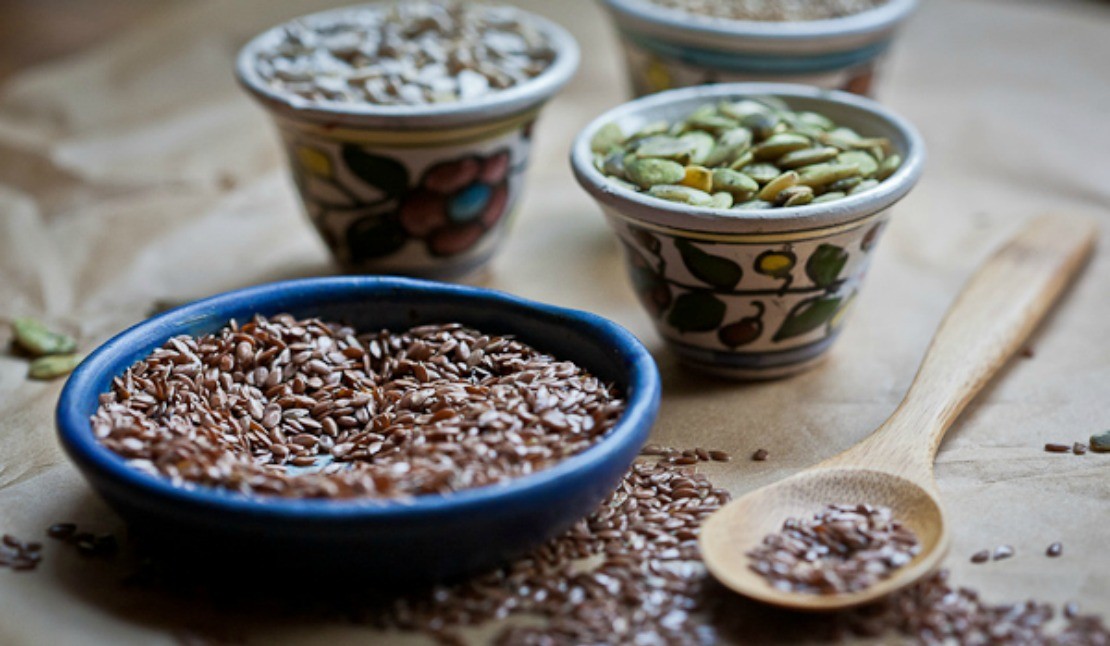
Seed Cycling For Hormonal Balance
While there are countless advantages to being alive today, there are influences we must contend with in an industrialized world. Electric lights interfere with our sleep cycle hormones. Women long ago had children earlier and breastfed longer, which decreased their exposure to natural estrogen. We spend less time being physically active than our predecessors. Xenoestrogens and endocrine disruptors disturb our hormonal ecology. There are times when we might try herbal support, like the female-friendly hormonal “normalizer” chaste tree berry (vitex). And sometimes we might try nutritional support through seed cycling, which according to some practitioners, provides our bodies with the raw elements it needs to maintain hormonal balance (Jesswein, 2012).
Whether we’re aware of it or not, our bodies and minds are exquisitely sensitive to the elements swirling around us and in us, from the weather to the lunar cycle to the natural ebb and flow of our hormones. These influences may manifest as sleepless nights while the moon is full, tendencies towards napping during winter, restlessness during spring, and heightened senses the week prior to menstruation. We may expect our bodies to work like the dependable, predictable machines all around us, instead of honoring our natural rhythms and internal energies.
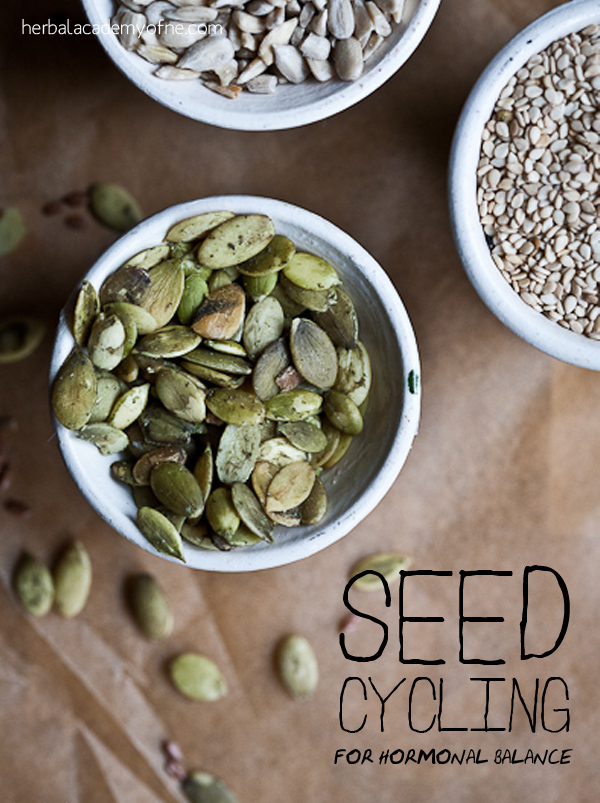
As much as we wish we could simply restart or reboot ourselves, we can instead notice these subtle (and not-so-subtle) shifts and celebrate them as the natural responses of our living, breathing bodies to the forces moving within and around us: a dance with the elements.
When considering the pre-menstrual woman, it’s important to distinguish between what is natural from those symptoms caused by other factors. A natural ebb and flow of hormones may cause a noticeable monthly change in sensitivity and energy, a change which can be honored and celebrated as a part of womanhood. However, for various reasons, some women experience debilitating symptoms from a hormonal imbalance, which can cause excruciating cramps and breast soreness, and irregular periods or amenorrhea.
Fortunately, our livers do wonderful jobs at maintaining balance, detoxifying, and metabolizing hormones, especially when we optimize liver function through the use of bitter herbs. When our livers aren’t working at their optimal level, metabolism and excretion of estrogen is slowed; hormones then continue to circulate in the body and stir up troublesome symptoms.
What is Seed Cycling?
Seed cycling integrates different seeds into the diet at different times in the menstrual cycle to support optimal hormonal balance (Jesswein, 2012). The idea is that seeds carry certain oils, vitamins, and nutrients that can help support the body’s production, release, and metabolism of hormones. The seeds used in seed rotation are flax and pumpkin seeds, and sesame and sunflower seeds.
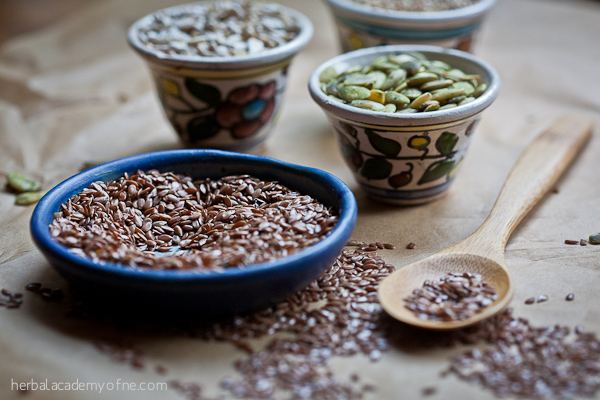
Proponents of seed cycling say that lignans in sesame seeds and flax can help the body bind excess estrogen, supporting its release, and that omega-3s help cellular receptor sites to remain in good condition, which in turn keeps hormones in balance. Certain seeds are high in vitamins or minerals like zinc and selenium that help support hormone release.
How to Seed Cycle
The seeds are rotated based on the follicular and luteal phases. The follicular phase of your cycle starts with “Day 1,” which is the first day of your menstrual cycle and the day that you begin to bleed. The luteal phase begins with ovulation and extends to menses. For some women, ovulation falls on or around day 14 or 15, but many women ovulate much sooner or much later. In addition, some women experience shorter or longer cycles than the “ideal” 28-day cycle, so it’s important to know your body’s rhythms and read its signs.
Follicular Phase: Day 1 to Day 14, or until ovulation:
1 tablespoon each freshly ground raw flax seeds and pumpkin seeds daily.
Luteal Phase: From Day 15 (about) to 28, or until menses:
1 tablespoon each freshly ground raw sunflower and sesame seeds daily.
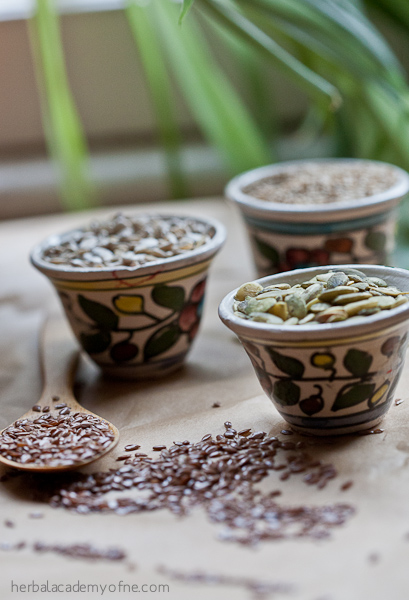
Evidence for Seed Cycling – Nothing But the Flax
Aside from anecdotal reports, the effects of seed cycling have not been documented. But some research indicates that individual seeds used in the seed cycling method may indirectly affect menstrual cycles and can play a role in reducing some PMS and menopausal symptoms. Flax appears to be the most researched seed.
For example, a study in 1993 found that women taking one tablespoon of flax powder daily lengthened the luteal phase (latter half of the cycle) and resulted in fewer anovulatory cycles (months with no ovulation). The researchers determined that while flax had no significant effect on luteal phase progesterone concentrations, “the luteal phase progesterone/estradiol ratios were significantly higher during the flax cycles” (Phipps et al., 1993).
In a later study, women who consumed a daily muffin with 25 grams of flax seed for three months had significantly reduced breast pain at the beginning of the menstrual cycle (Goss et al., 2000).
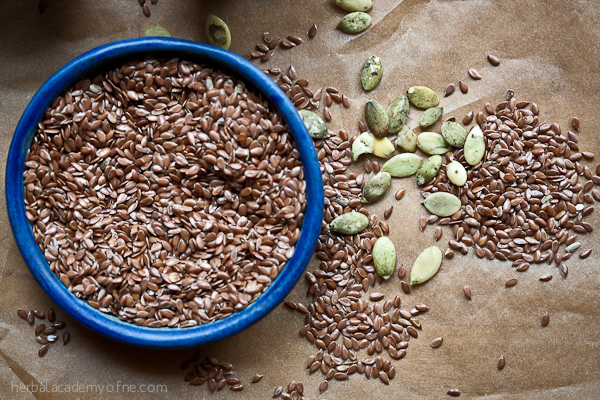
Other studies have shown a reduction of hot flashes in women using flax, although some studies have shown no benefit for menopausal symptoms.
A 2011 study showed that pumpkin seed oil improved HDL cholesterol levels in postmenopausal women and decreased menopausal symptoms including the severity of hot flashes, and resulted in fewer headaches and less joint pain (Gossell-Williams et al., 2011).
In 2012, a German study concluded that increased consumption of phytoestrogen-rich sunflower and pumpkin seeds resulted in reduced postmenopausal breast cancer risk (Zaineddin et al., 2012).
While none of these studies tell us anything about seed cycling specifically, they indicate that certain seeds may play an active role in our hormonal ecology. At the very least, adding this protocol into our lives offers us a nourishing ritual based on our natural rhythms.
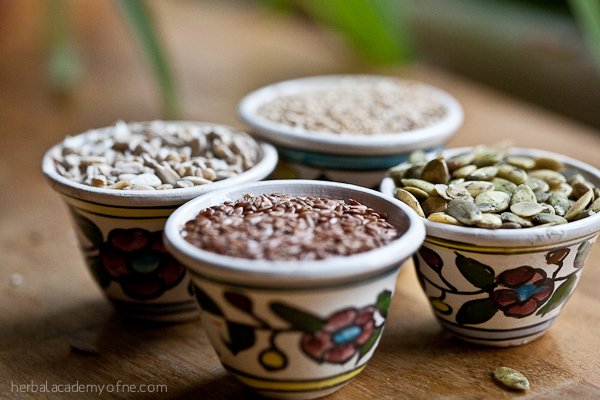
Tips for Happy Hormones and Seed Cycling Secrets
- Check in with your doctor to ensure there isn’t a serious underlying reason for your more debilitating symptoms.
- Become aware of your hormonal shifts, and take the time to honor them through ritual or self-care.
- Practice sleep hygiene. Turn down the lights at dusk and remove light-emitting devices from your bedroom (including smart phones and computers, etc.).
- Look to the liver! Strategies include eating beets and taking bitters.
- Baby your intestinal flora with fermented and cultured foods.
- Maintain a healthy body weight – neither too light nor too heavy.
- Stay active and move your body daily.
- Minimize exposure to toxins in your daily life.
- Grind your seeds! This will help your body digest them, especially flax seeds, which can simply pass right through you intact.
- Invest in a good grinder, reserved especially for seeds and herbs.
- Sesame seeds are available with their hulls intact (unhulled) or with the shells removed (hulled). Unhulled are higher in calcium, which has been shown to reduce symptoms in the luteal phase but are high in oxalates which may not be appropriate for some people. Check with your doctor.
- Use organic seeds if possible, to minimize any potential hormonal disruptors in agricultural chemicals.
- Sprinkle your ground seeds into oatmeal, on salads, in yogurt, or blend into smoothies.
- Keep a journal to mark your symptoms through your seed cycling experience. It is said that benefits of seed cycling will appear in about three months.
Additional Resources
Menstruation: The Sacred Cycle: Redefining our menstrual cycle and PMS, a must-read article by Gina Cloud
Women’s Bodies, Women’s Wisdom, the classic guide to living well in a woman’s body by Christiane Northrup, MD
Beautiful Girl: Celebrating the Wonders of Your Body, a guide for girls on the power and beauty of becoming a women by Christiane Northrup, MD
The Ecology of Estrogen in the Female Body, superb and in-depth article by herbalist Juliet Blankespoor
REFERENCES
Jesswein, L. (2012). Seed Cycling for Natural Hormonal Balance. Retrieved from http://naturalhealthperspectives.blogspot.com/2012/02/seed-cycling-for-natural-hormonal.html
Phipps, W.R., Martini, M.C., Lampe, J.W., Slavin, J.L., Kurzer, M.S. (1993). Effect of flax seed ingestion on the menstrual cycle. Journal of Clinical Endocrinology & Metabolism, 77(5):1215 – 1219
Goss, P.E., Li, T., Theriault, M., Pinto, S., Thompson, L.U. (2000). Effects of dietary flaxseed in women with cyclical mastalgia. Breast Cancer Research and Treatment, 64:49
Gossell-Williams, M., Hyde, C., Hunter, T., Simms-Stewart, D,. Fletcher, H., McGrowder, D., Walters, C.A. (2011). Improvement in HDL cholesterol in postmenopausal women supplemented with pumpkin seed oil: pilot study. Climacteric, 14(5):558-64.
Zaineddin, A.K., Buck, K., Vrieling, A., Heinz, J., Flesch-Janys, D., Linseisen, J., Chang-Claude, J. (2012). The association between dietary lignans, phytoestrogen-rich foods, and fiber intake and postmenopausal breast cancer risk: a German case-control study. Nutrition and Cancer, 64(5):652-65.








